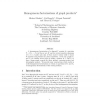Free Online Productivity Tools
i2Speak
i2Symbol
i2OCR
iTex2Img
iWeb2Print
iWeb2Shot
i2Type
iPdf2Split
iPdf2Merge
i2Bopomofo
i2Arabic
i2Style
i2Image
i2PDF
iLatex2Rtf
Sci2ools
DM
2008
2008
Homogeneous factorisations of graph products
A homogeneous factorisation of a digraph consists of a partition P = {P1, . . . , Pk} of the arc set A and two vertex-transitive subgroups M G Aut() such that M fixes each Pi setwise while G leaves P invariant and permutes its parts transitively. Given two graphs 1 and 2 we consider several ways of taking a product of 1 and 2 to form a larger graph, namely the direct product, cartesian product and lexicographic product. We provide many constructions which enable us to lift homogeneous factorisations or certain arc partitions of 1 and 2, to homogeneous factorisations of the various products.
| Added | 10 Dec 2010 |
| Updated | 10 Dec 2010 |
| Type | Journal |
| Year | 2008 |
| Where | DM |
| Authors | Michael Giudici, Cai Heng Li, Primoz Potocnik, Cheryl E. Praeger |
Comments (0)

